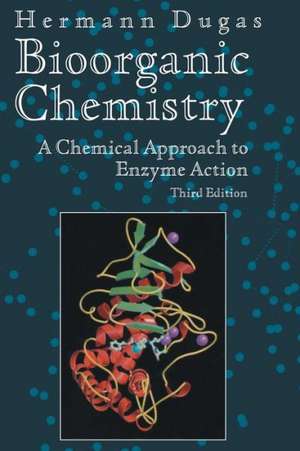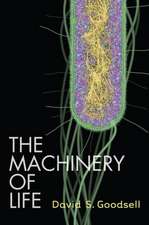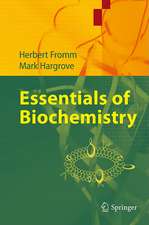Bioorganic Chemistry: A Chemical Approach to Enzyme Action: Springer Advanced Texts in Chemistry
Autor Hermann Dugasen Limba Engleză Paperback – 27 aug 1999
Preț: 412.41 lei
Nou
Puncte Express: 619
Preț estimativ în valută:
78.94€ • 85.77$ • 66.35£
78.94€ • 85.77$ • 66.35£
Carte tipărită la comandă
Livrare economică 21 aprilie-05 mai
Preluare comenzi: 021 569.72.76
Specificații
ISBN-13: 9780387989105
ISBN-10: 0387989102
Pagini: 700
Ilustrații: XVIII, 700 p. 119 illus., 6 illus. in color.
Dimensiuni: 155 x 235 x 34 mm
Greutate: 0.99 kg
Ediția:3rd ed. 1996. 2nd printing 1999
Editura: Springer
Colecția Springer
Seria Springer Advanced Texts in Chemistry
Locul publicării:New York, NY, United States
ISBN-10: 0387989102
Pagini: 700
Ilustrații: XVIII, 700 p. 119 illus., 6 illus. in color.
Dimensiuni: 155 x 235 x 34 mm
Greutate: 0.99 kg
Ediția:3rd ed. 1996. 2nd printing 1999
Editura: Springer
Colecția Springer
Seria Springer Advanced Texts in Chemistry
Locul publicării:New York, NY, United States
Public țintă
GraduateCuprins
1 Introduction to Bioorganic Chemistry.- 1.1 Basic Considerations.- 1.2 Proximity Effects in Organic Chemistry.- 1.3 Molecular Adaptation.- 1.4 Molecular Recognition and the Supramolecular Level.- 2 Bioorganic Chemistry of Amino Acids and Polypeptides.- 2.1 Chemistry of the Living Cells.- 2.2 Analogy Between Organic Reactions and Biochemical Transformations.- 2.3 Chemistry of the Peptide Bond.- 2.4 Nonribosomal Peptide Bond Formation.- 2.5 Asymmetric Synthesis of ?-Amino Acids.- 2.6 Asymmetric Synthesis with Chiral Organometallic Catalysts.- 2.7 Transition State Analogs.- 2.8 Antibodies as Enzymes.- 2.9 Chemical Mutations.- 2.10 Molecular Recognition and Drug Design.- 3 Bioorganic Chemistry of the Phosphate Groups and Polynucleotides.- 3.1 Basic Considerations.- 3.2 Energy Storage.- 3.3 Hydrolytic Pathways and Pseudorotation.- 3.4 DNA Intercalants.- 4 Enzyme Chemistry.- 4.1 Introduction to Catalysis.- 4.2 Introduction to Enzymes.- 4.3 Multifunctional Catalysis and Simple Models.- 4.4 ?-Chymotrypsin.- 4.5 Other Hydrolytic Enzymes.- 4.6 Stereoelectronic Control in Hydrolytic Reactions.- 4.7 Immobilized Enzymes and Enzyme Technology.- 4.8 Enzymes in Synthetic Organic Chemistry.- 4.9 Enzyme-Analog-Built Polymers.- 4.10 Design of Molecular Clefts.- 5 Enzyme Models.- 5.1 Host-Guest Complexation Chemistry.- 5.2 New Developments in Crown Ether Chemistry.- 5.3 Membrane Chemistry and Micelles.- 5.4 Polymers.- 5.5 Cyclodextrins.- 5.6 Enzyme Design Using Steroid Template.- 5.7 Remote Functionalization Reactions.- 5.8 Biomimetic Polyene Cyclizations.- 6 Metal Ions.- 6.1 Metal Ions in Proteins and Biological Molecules.- 6.2 Carboxypeptidase A and the Role of Zinc.- 6.3 Hydrolysis of Amino Acid Esters and Amides and Peptides.- 6.4 Iron and Oxygen Transport.- 6.5 Copper Ion.- 6.6Biomodels of Photosynthesis and Energy Transfer.- 6.7 Cobalt and Vitamin B12 Action.- 7 Coenzyme Chemistry.- 7.1 Oxidoreduction.- 7.2 Pyridoxal Phosphate.- 7.3 Suicide Enzyme Inactivators and Affinity Labels.- 7.4 Thiamine Pyrophosphate.- 7.5 Biotin.- 8 Molecular Devices.- 8.1 Introduction to Self-Organization and Self-Assembly.- 8.2 General Overview of the Approach.- 8.3 Specific Examples.- References.
















